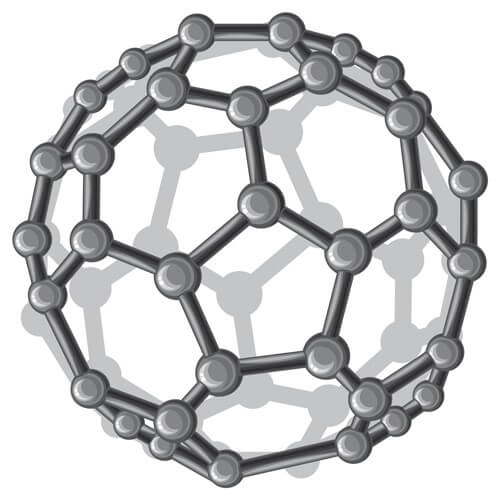Carbon-60 molecules (fullerenes, buckeye balls) have the ability to extract precious metals from liquids, including water and polluted environments. After experiments with several metals, researchers found that the charge and the ionic radius of the Buckeye sphere derivatives are the factors that influence the nature of the binding of the metals to them.

[Translation by Dr. Nachmani Moshe]
Carbon-60 molecules (fullerenes, buckeye balls) have the ability to extract precious metals from liquids, including water and polluted environments. After experiments with several metals, researchers found that the charge and the ionic radius of the Buckeye sphere derivatives are the factors that influence the nature of the binding of the metals to them.
The hydroxyl derivatives of buckeye balls not only enable the recovery of valuable materials and toxic metal particles found in water reservoirs or in other liquids, but they enable their reuse there in the future, according to researchers from Rice University.
In the chemistry laboratory of researcher Andrew Barron at Rice University, they discovered that fullerenes (carbon-60, Bucky balls, Wikipedia) that have undergone a chemical process known as hydroxylation (introduction of hydroxyl groups) aggregate together into a structure of a string of pearls during their association with metals in solutions. Possible uses of this process include the environmentally friendly removal of metals (toxic and valuable) from fluids used in mining, as well as from fluids used in hydraulic fracturing in the fuel manufacturing industry.
The lead researcher points out that derivatives of bucky balls were able to bind to them metal atoms with different electrical charges in unexpected ways, a finding that implies that it will be possible to bind specific metals from a mixture of liquids while leaving other metals in solution. The research findings have long been published in the scientific journal Dalton Transactions.
Previous research in the same laboratory showed that hydroxyl derivatives of fullerenes (known as fullerenols) bind to iron ions to form an insoluble polymer. The researchers conducted a series of experiments in order to examine the relative binding capacity of fulleranols to a variety of metals. "It's all well and good to claim that I can extract metals from water, but for more complex liquids, the problem is extracting the metals you really need," explains the researcher. "Liquid waste from the mining industry, for example, contains large amounts of iron and aluminum and small amounts of nickel, zinc and copper, and you really need those. To be honest, iron and aluminum aren't the worst metals your water can have in it, as they are found in natural water anyway. Our goal was to find if there are bonding preferences between the different metals, and we found them."
A microscope image (TEM) showed that clusters of "strings of pearls" were formed when the hydroxyl derivatives of carbon-60 were bound to metals - in this case, iron and nickel - within the solution. The findings imply that it will be possible to selectively remove specific metal molecules from metal mixtures in solution. The researchers found that the metals bound to the fulleranols were all positive ions with a positive electrical charge of 2 or 3 excess protons. "Normally, the larger the metal, the faster it separates," says the lead researcher. However, the experiments showed otherwise - metals with a charge of 2 and a smaller ionic radius bonded better than larger metals (among these - zinc bonded the strongest). However, for plus 3 ions, the larger ones worked better than the smaller ones. "The surprising finding leads us to the conclusion that in the future we will be able to selectively exhaust the metals we want."
The research showed that fulleranols bind to dozens of metals, turning them into solid cross-linked polymers. The order of bonding efficiency, starting with the best metal, is: zinc, cobalt, manganese, nickel, lanthanum, neodymium, cadmium, copper, silver, calcium, iron and aluminum. The reference to "string" is not a typo - one of the inspirations for the research was the fact that metal ions are known as cross-linking agents for proteins that provide marine creatures with a miraculous ability to stick to wet rocks.
The lead researcher explains that fulleranols function as trapping agents that determine how different ions and molecules will bind to metal ions. Experiments with different metals showed that the fulleranols bind to them in less than a minute and become filterable solids. The researchers say that their choice to focus on aluminum, zinc and nickel was due to the fact that these metals are found together with iron in the waste fluids of the mining industry. Similarly, cadmium is tested in light of the fact that it is present together with fertilizers and sewage streams and copper is present together with the exhaust fluids from quarrying. Nickel, lanthanum and neodymium are the name metals in the battery and hybrid car industry.

One response
It is worth noting that these materials are named after Buckminster Fuller, a genius American futurist and architect who invented, among other things, the Gioadzi pedestal.